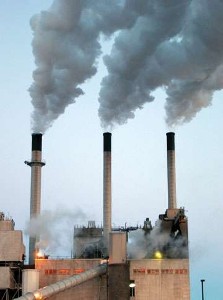Chemical engineers at Massachusetts Institute of Technology devised a lab-scale process that can more efficiently remove carbon dioxide from fossil-fuel emissions and work more readily with today’s power plants than current technologies. The team led by MIT’s Alan Hatton published its findings online earlier this month in the journal Energy and Environmental Science.
Current emission-control systems use scrubbers that harness amines, hydrocarbon and nitrogen compounds related to ammonia. In conventional systems, amines bind to CO2 in the plant’s emissions, with the CO2 released from the amines when heated in a separated chamber. The heat required in current scrubbing processes, however, can use as much as half of the power plant’s low-pressure steam, and fitting this technology into existing plants requires extensive renovations to the plant, often making the process economically unfeasible.
Hatton and colleagues developed an alternative process, which like the current process uses common and readily available amines to bind with the CO2, but instead removes the CO2 from the amines with an electrochemical method rather than steam. In the new process, amines are added at the top of the emission column, with the effluent gases rising from below. The amines bind with the CO2, and collect at the bottom of the column as a liquid.
To process the liquid compound, a charged metal electrode — the researchers tested copper — separates the CO2 from from the amines. The CO2 is released under pressure, and the amines can be recovered for reuse.
The MIT team ran simulation models and created a lab-scale model of the system, which suggest the alternative process is capable of removing up to 90 percent of the CO2 from power plant emissions, a percentage comparable to current technologies. However, the alternative process takes about 25 percent of the plant’s generated energy to process the emissions, rather than the 40 percent required in current systems.
The alternative process is a modular system that can be added to current power plant without the extensive renovations required of current methods. The new process also requires electricity — the power plant’s product — to process the emissions. During peak-load periods, the process can be minimized to reduce the drain on the plant’s output.
In addition, the CO2 is released under pressure. If the emissions processing unit is used in a plant that is storing or sequestering the CO2, the pressurized form will make it easier to collect than current systems requiring a separate compressor.
Hatton and colleagues say the process can also be applied to other industries, such as cement, that generate large amounts of CO2, since it does not require steam to separate the CO2 from emissions. The process could likewise remove CO2 from enclosed environments, such as submarines, where accumulations of the gas would be dangerous to human inhabitants.
Read more:
- Energy-Efficient Process Devised to Convert CO2 to Methanol
- Material Engineered to More Efficiently Capture CO2
- Process Converts Greenhouse Gas into Useful Chemicals
- Simple Process Developed to Remove Smokestack CO2 Emissions
- Study Aims for Improved Oil Extraction Methods Using CO2
* * *


 RSS - Posts
RSS - Posts
You must be logged in to post a comment.